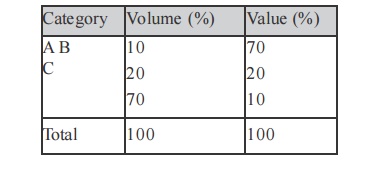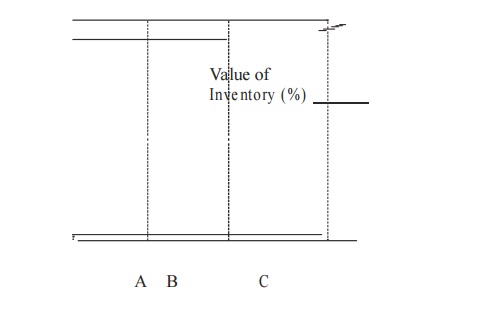Chapter: Business Science : Financial Management : Working Capital Management
Inventory Management
Inventory Management
Introduction
Inventories
constitute the most significant part of current assets of the business concern.
It is also essential for smooth running of the business activities.
A proper
planning of purchasing of raw material, handling, storing and recording is to
be considered as a part of inventory management. Inventory management means,
management of raw materials and related items. Inventory management considers
what to purchase, how to purchase, how
much to purchase, from where to
purchase, where to store and when to use
for production etc.
Meaning
The dictionary meaning of the inventory is stock
of goods or a list
of goods. In accounting language, inventor y means stock
of finished goods. In a manufacturing point of view, inventory includes, raw material,
work in process, stores, etc.
1 Kinds of Inventories
Inventories
can be classified into five major
categories.
Raw
Material
It is basic and important
part of inventories. These are goods
which have not yet been committed to production in a manufacturing business concern.
Work in Progress
These include those
materials which have been committed to production
process but have not yet
been completed.
Consumables
These are the materials which are
needed to smooth running of the
manufacturing process.
Finished Goods
These are the final output of the
production process of the business concern. It is ready for consumers.
Spares
It
is also a part of inventories, which
includes small spares
and parts.
2 Objectives of Inventory Management
The major objectives of the inventory manage me nt are as follows:
To efficient and smooth
production process.
To maintain optimum inventory to
maximize the profitability.
To meet the seasonal demand of the products.
To avoid price increase in
future.
To ensure the level and site of inventories
required.
To plan when
to purchase and where to purchase
To avoid both
over stock and under stock
of inventory.
3 Techniques of Inventory Management
Inventory management
consists of effective control and ad ministration of inventories. Inventory control refers to a system which ensures supply of required quantity and quality of inventories at the required
time and at the same time prevent unnecessary investment
in inventories. It needs the following
important techniques.
Inventory
management techniques may be classified
into various types:
A.
Techniques based on the order quantity of Inventories
Order
quantity of inventories can be deter mined with the help of the following
techniques :
Stock Level
Stock
level is the level of stock which is maintained by the business concern at all
times. Therefore, the business concern must maintain optimum level of stock to
smooth running of the business process. Different level of stock can be determined
based on the volume of the stock.
Minimum Level
The
business concern must maintain minimum level of stock at all times. If the
stocks are less than the minimum level, then the work will stop due to shortage
of material.
Re-order Level
Re-ordering
level is fixed between minimum level and maximum level. Re-order level is the
level when the business concern makes fresh order at this level.
Re-order
level= maximum consumption × maximum Re-order period.
Maximum Level
It is the
maximum limit of the quantity of inventories, the business concern must maintain.
If the quantity exceeds maximum level limit then it will be overstocking.
Maximum level = Re-order level + Re-order quantity – (Minimum consumption ×
Minimum delivery period)
Danger Level
It is the
level below the minimum level. It leads to stoppage of the production process.
Lead Time
Lead time
is the time normally taken in receiving delivery after placing orders with
suppliers. The time taken in processing the order and then executing it is kno
wn as lead time.
Safety Stock
Safety
stock implies extra inventories that can be drawn down when actual lead time
and/ or usage rates are greater than expected. Safety stocks are deter mined by
opportunity cost and carrying cost of inventories. If the business concerns
maintain low level of safety stock, it will lead to larger opportunity cost and
the larger quantity of safety stock involves higher carrying costs.
Economic Order Quantity (EOQ)
EOQ
refers to the level of inventory at which the total cost of inventory
comprising ordering cost and carrying cost. Determining an optimum level
involves two types of cost such as ordering cost and carrying cost. The EOQ is
that inventor y level that minimizes the total of ordering of carrying cost.
EOQ can
be calculated with the help of the mathematical formula:

Where,
a =
Annual usage of inventories (units)
b =
Buying cost per order
c =
Carrying cost per unit
4 Techniques Based On The Classification Of
Inventories
A-B-C analysis
It is the
inventory management techniques that divide inventory into three categories
based on the value and volume of the inventories; 10% of the inventory‘s item
contributs to 70% of value of consumption and this category is known as A
category. About 20% of the inventor y item contributes about 20% of value of
consumption and this category is called category B and 70% of inventor y item
contributes only 10% of value of consumption and this category is called C
category.
Inventory Breakdown Between Value and Volume

ABC analysis can be explained with the help of the following
Graphical presentation.

Inventories
Inventor
ies are classified according to the period of their holding and also this
method helps to identify the movement of the inventories. Hence, it is also
called as, FNSD analys is—
where,
F = Fast
moving inventories
N =
Normal moving inventories
S = Slow
moving inventories
D = Dead
moving inventories
VED Analysis
This
technique is ideally suited for spare parts in the inventory management like
ABC analysis. Inventories are classified into three categories on the basis of
usage of the inventories.
V = Vital item of inventories
E = Essential item of inventories
D = Desirable item of inventories
HML Analysis
Under this analysis, inventories are classified into three
categories on the basis of the value of the inventories.
H = High value of
inventories
M = Medium value of inventories
L = Low value of inventories
Techniques On The Basis Of Records
A. Inventory budget
It is a
kind of functional budget which facilitates the estimated inventory required
for the business
concern during a particular period. This budget is prepared based
on the
past experience.
B. Inventory reports
Preparation
of periodical inventory reports provides information regarding the order level,
quantity to be procured and all other information related to inventories. On the
basis of these reports, Management takes necessary decision regarding
inventory
control and Management in the business concern.
Valuation of Inventories
Inventories
are valued at different methods depending upon the situation and
nature of
manufacturing process. Some of the major methods of inventory
valuation
are mentioned as follows:
First in First Out Method (FIFO)
v Last in First Out
Method (LIFO)
v Highest in First Out Method (HIFO
v Nearest in First Out Method (NIFO)
v Average Price Method
v Base Stock Method
v Standard Price Method
v Market Price Method
Related Topics